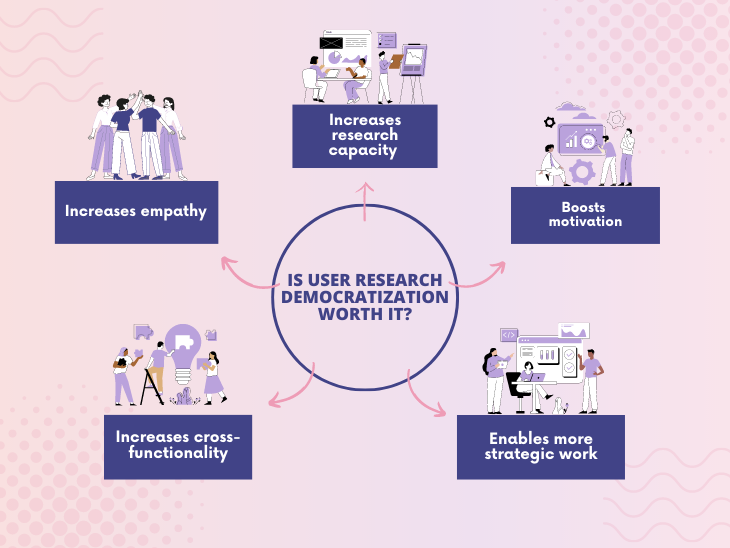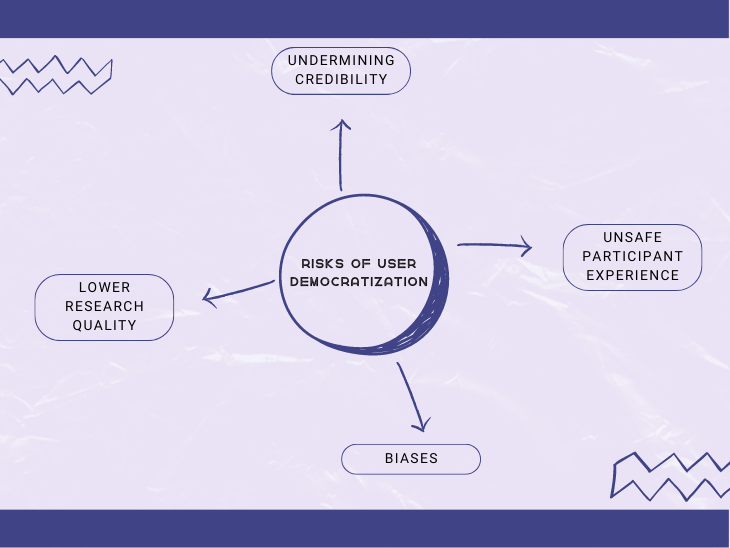With time, we have learned that product discovery and user research are crucial for product success. It has become so vital that it’s no longer just a domain of UX researchers. The current trend is to engage everyone in user research.

Engaging the whole team in the process of user research and discovering user needs and pains is known as the democratization of user research. Although tempting, it also comes with its own challenges and risks.
Let’s dig deeper into the topic of user research democratization.
User research democratization is quite a broad term. Although all activities designed to empower the team to help with user research constitute democratization, we can distinguish different levels of it. At a high level, we can democratize:

We start with democratizing access, which means allowing everyone to access, view, and analyze user research results. This includes access to:
Though, it’s not only about access. The whole company must go through the process of establishing a research culture. People should not only have the capacity to understand research results; they should be encouraged and rewarded to draw conclusions and spot insights within the results.
Employing the right culture and allowing access to the results will result in a team that builds up user empathy. The best thing about user empathy is that it will always lead to more valuable insights and thus a better product.
You reach a new level of user research democratization by encouraging everyone to participate in the research process.
For example, non-UX researchers could be:
Non-researchers can also participate in post-research work while also remembering that there is a difference between passively participating and actively participating.
For example, they can:
This way, not only do they take some work off UX researchers’ shoulders, but this approach also effectively builds user empathy and problem understanding.
With enough exposure and proper training, you could think about engaging the whole team in running research activities.
At this level, UX researchers are still responsible for planning the studies, including their form and quantity, but more people can participate as facilitators. For example, you could have a developer conduct usability studies with users or QA to interview users.
One of the biggest benefits of democratizing facilitation is increased research capacity and team cross-functionality. It also allows your UX people to spend more time on high-level, strategic activities.
However, it comes at a cost and is riddled with significant risks:
The transition to this level should be intentional, slow, and thoroughly mediated. Don’t just democratize facilitation for the sake of being cool. Make sure you have a strong enough reason to endure the challenges it brings.
The highest form of democratization, democratizing ownership, allows everyone to run UX studies as they see fit within established boundaries.
If a QA is unsure about the feature they just tested, they can run an ad hoc usability study, or if a developer isn’t sure what scope cut to recommend, they can chat with a few users to better understand the problem they are solving.
UX researchers have the responsibility of establishing the right boundaries. These boundaries can include:
UX researchers should set these boundaries to ensure they have the highest-quality research.
Although the vision might be tempting, let’s have a quick reality check: only the most mature and skilled teams should even think about democratizing ownership.
It’s like a holy grail, most teams will never get to this, and that’s okay.
If democratizing user research takes time, lots of effort, and has many risks and challenges, is it even a worthy endeavor?
Yes! There are many advantages that makes user research democratization worth all the time and effort. Some of those advantages include:

The closer people are to the user, the more empathy they develop. Participating in user research allows the team to experience user problems firsthand rather than just listening to them from the researcher.
With increased empathy for their users, the team will end up creating an even better product with more attention to what the consumer wants.
With more people engaged in user research, even to a limited extent, the team’s overall research capacity increases. You can validate more assumptions, test more hypotheses, and reduce more risks.
Teams that are closer to users tend to have higher overall motivation. Research democratization allows them to experience user problems and see how their solutions solve them. Features are no longer just items in Jira but real solutions to problems.
With the whole team taking care of smaller things, researchers can work on bigger picture problems, perhaps at the companywide level. They can leverage their expertise by building continuous discovery habits across all departments and facilitating the transition from a feature factory to an outcome-driven company.
Naturally, with smaller UX research teams, there will be bottlenecks. You will have to prioritize research topics which will slow down the improvement process.
If everyone on the team can conduct or analyze user research, you reduce that bottleneck and get to every research topic. Likewise, if your UX researcher is gone for a long period of time, you can still maintain your basic research processes.
It’s not all sunshine and roses, though. User research democratization comes with risks, and if you don’t take them seriously, you can do more harm than good.
Some of the risks associated with user democratization include:

We are all full of our own biases. Good UX researchers are trained to spot whenever they have biased interpretation, and learn to ignore it. They are also skilled in noticing small details and identifying user emotions.
That is not something you can teach and learn in one week. You learn it through training, but more importantly through years of experience. With non-researchers engaged in the process, it’s only natural that more misinterpretations will appear and important details will be missed.
Another area a UX researcher is heavily trained in is providing a safe and inclusive experience for participants. Professional researchers know how to ask sensitive questions appropriately.
With non-researchers included, it’s more difficult to guarantee such a level of emotional safety.
I’ve noticed that when people are engaged in user research for the first time, they tend to underappreciate the complexity of the process.
They tend to ask questions along the lines of, “All you need to do is to ask a few questions; what’s so hard?”
They don’t realize all the skills and effort required to get truly valuable insights from the research. This can lead to tensions between teams and members.
On one hand, relying fully on professional UX researchers is limiting and not scalable. It also disempowers the product team.
On the other hand, you can’t just delegate all user research to the team and ignore the expertise needed to make the process safe and of high quality.
It’s all about striking the right balance between engaging professionals and democratizing research.
Non-researchers can build empathy and user understanding by focusing on safe user research areas, such as:
These activities will bring insights to the team, and if some of these insights are wrong, they rarely do that much harm. In the long run, if everyone gets proper training, the process should bring more positive outcomes.
By democritizing user research, you allow your UX researchers to focus more on truly mission-critical work.
This can include:
At the end of the day, you can’t replace a skilled UX researcher with democratization. User research democratization is here to help you get the most out of your UX team.

User research democratization can help you build truly autonomous, empathic, and empowered teams. However, not everything can be democratized, and not every team requires the same level of democratization.
Start with the first level: democratizing access. Build a culture where being up-to-date with the latest research and insights is natural.
Once you are there, ask yourself three questions to decide whether you should move to another level or not:
Without a team that’s already highly mature and fluent on their current level, democratization will do more harm than good.
User democratization is like a double-edged sword. It can be a powerful weapon, but if you handle it poorly, you can seriously harm yourself.
Featured image source: IconScout

LogRocket identifies friction points in the user experience so you can make informed decisions about product and design changes that must happen to hit your goals.
With LogRocket, you can understand the scope of the issues affecting your product and prioritize the changes that need to be made. LogRocket simplifies workflows by allowing Engineering, Product, UX, and Design teams to work from the same data as you, eliminating any confusion about what needs to be done.
Get your teams on the same page — try LogRocket today.

A practical guide for PMs who want to stop being bottlenecks, delegate smarter, and lead teams effectively with a clear ownership framework.

Stop letting unreliable data block features. Treat data as inventory to track quality, ownership, and ship with confidence.

Learn why slide decks slow teams down and explore better tools like whiteboards, PRDs, and prototypes to improve collaboration and alignment.

AI PM roles are evolving fast. Learn the five types of AI PMs, the skills they need, and how they shape AI products across industries.